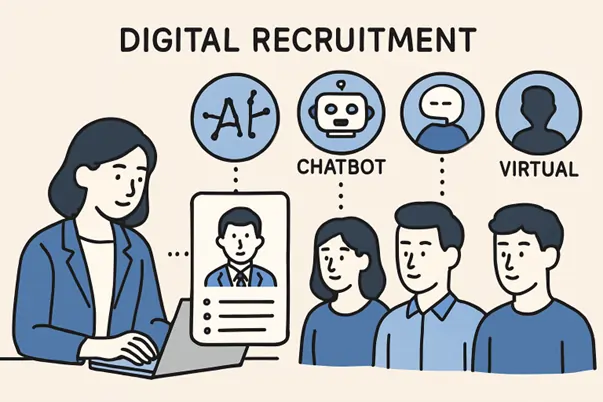Introduction
Technology continues to transform every aspect of talent acquisition. Today’s businesses are leveraging advanced tools, from AI automation to immersive simulations, to find and hire top talent faster and more effectively than ever before. Companies keen on innovative approaches are now exploring alternatives—like an EA staffing agency—that offer cutting-edge recruiting solutions tailored to modern workplace needs.
The recruitment landscape for employers and job seekers is becoming more digital, data-driven, and candidate-centered. These technological advancements are improving operational efficiency, helping organizations attract a broader range of candidates, and providing a far better experience throughout the hiring process.
Technology is a cornerstone of innovative hiring strategies, from streamlining the application process through mobile-friendly platforms to enhancing fairness with AI-driven analytics. Applicants increasingly expect engaging, responsive, transparent processes, pushing employers to adapt quickly.
This article explores the most influential technological trends in recruitment and how they address persistent challenges like bias, inefficiency, and candidate disengagement. Companies that do not adapt to these innovations risk falling behind in the talent arms race.
AI in Recruitment
Artificial intelligence is now the bedrock of innovative recruitment. AI-powered algorithms process vast applications in seconds, streamlining initial resume reviews and highlighting the best matches for specific roles. According to a Harvard Business Review analysis, recruiters using AI tools have significantly reduced time-to-hire and increased the volume and quality of talent pipelines.
These platforms aren’t just about speed—they deliver predictive analytics that can anticipate future employee success by analyzing historical performance data. By automating repetitive tasks, recruiters reclaim time to focus on critical decisions and strategies.
Minimizing Human Bias
One of AI’s most significant advantages is reducing unconscious bias. Algorithms evaluate candidates based on skills and experience, not by gender, ethnicity, or age. However, these AI systems must be regularly audited to avoid reinforcing existing inequalities through biased data inputs.
Virtual Reality Assessments
Virtual reality (VR) in recruitment offers immersive, engaging candidate assessments. Simulated workplace scenarios provide organizations with a safe and controlled method to test how candidates perform critical tasks or respond to real-world pressures. This method offers a far richer understanding of applicants than conventional interviews.
For instance, major firms in sectors like engineering and customer service have developed VR simulations to replicate everyday work challenges. This helps candidates and employers evaluate suitability and job fit before making commitments—a strategy increasingly highlighted by experts at sources such as Forbes.
Mobile Recruiting
With more than 80% of job seekers using mobile devices to browse and apply for roles, recruiting has gone mobile. Responsive design in careers portals and applications that efficiently function on smartphones means candidates can quickly apply, upload CVs, and track their status from anywhere.
Mobile-first approaches open new talent pools and allow companies to reach passive candidates—those not actively looking but open to exciting opportunities—through social media and targeted mobile campaigns.
Data-Driven Decisions
Technology delivers a treasure trove of data to hiring teams. With applicant tracking systems (ATS) and HR analytics, recruiters now access deep insights into applicant tracking, time-to-fill metrics, and candidate demographics. This data makes it possible to consistently refine recruitment strategies, ensuring better matches for each open role.
Evaluating data retrospectively also empowers departments to spot possible bottlenecks and shortfalls—whether in candidate engagement or diversity. Employing data-driven choices sharpens competitive edges in crowded talent markets.
Chatbots for Candidate Engagement
Chatbots powered by advanced natural language processing have become essential in shaping modern candidate experiences. These AI-driven tools can manage repetitive but necessary tasks such as answering frequently asked questions, scheduling interviews, and offering real-time updates or feedback. This immediacy creates a smoother, faster, and more engaging process for applicants, enhancing overall satisfaction. By automating routine communication, chatbots free recruiters to dedicate their time to strategic functions—such as fostering meaningful connections with top talent and designing effective hiring strategies. The result is a recruitment process that is both efficient and personalized, benefiting organizations and candidates alike.
Gamification in Hiring
Gamification transforms talent acquisition by introducing interactive and engaging elements into the hiring process. Through competitive games, quizzes, and scenario-based challenges, companies move beyond traditional assessments to evaluate candidates on multiple dimensions, including technical expertise, critical thinking, creativity, and alignment with organizational culture. These activities provide a clearer picture of how applicants perform in real-world situations and create a more enjoyable and memorable recruitment experience. Candidates feel motivated to showcase their strengths dynamically, while employers stand out as innovative and forward-thinking. In a competitive labor market, gamification helps businesses attract, engage, and retain top talent..
Enhancing Diversity and Inclusion
Modern recruitment technology is a driving force for fairer, more inclusive talent pipelines. Intelligent screening solutions help neutralize biased language in job descriptions and promote skills-based hiring. Accessible application systems that support assistive technologies, screen readers, and multi-language options further ensure every qualified candidate has a chance.
Due to these digital interventions, organizations committed to diversity see legal benefits, improved team innovation, and employee satisfaction.
Conclusion
From precision-driven AI to immersive virtual reality and data-powered optimization, technology is transforming the recruitment landscape at every level. Artificial intelligence enables recruiters to identify qualified candidates more accurately, streamline resume screening, and reduce unconscious bias in selection. Virtual reality offers immersive ways to evaluate skills through realistic simulations, while data analytics provides actionable insights to refine hiring strategies and forecast workforce needs. These innovations enhance efficiency and scalability and promote inclusivity, transparency, and engagement throughout the hiring process. As competition for skilled professionals grows fiercer, organizations that strategically integrate these technologies will gain a decisive advantage. By creating a recruitment experience that is faster, fairer, and more interactive, businesses can consistently attract high-caliber candidates and build strong, future-ready teams capable of driving long-term success in a dynamic labor market.
Read more: How Predictive Maintenance is Transforming Industrial Operations – Dimensions Script
Term Life Policy Explained: Affordable Protection for Families – Dimensions Script
The Runway to Reality: How to Rock Curly Extensions for Black Hair at Any Event – Dimensions Script


